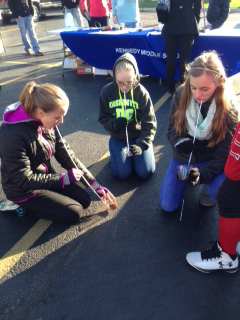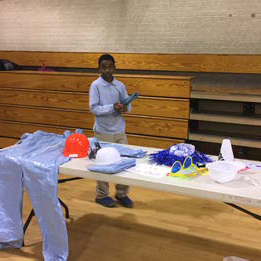Mrs. Beatty’s class would love for other people to come to Washington D.C., and get to experience all the fun projects we did. This blog is all about the things we did to get to Washington D.C., and how you could someday come too. We tried not to say exactly what to do, so that way you could have some fun experimenting and trying new things, just like us! We hope we´ll see you there someday!
Throughout the school-year of 2016/2017, Mrs. Beatty´s class studied the Science of Energy, the 10 energy sources and efficiency and conservation of energy. We paired with Mrs. Pommier´s class to make projects about what we studied in Efficiency and Conservation. Some of the projects talked about smog and acid rain, and how these can damage the environment. Some of the other projects talked about how Americans are wasting energy without realizing it, and how we can use energy efficiently. We invited the entire school to visit our classroom and see the final projects.
Three students went to a local radio station early in the morning, because they were being interviewed about their energy projects and their proposed trip to Washington D.C.. They mentioned the types of energy and how productive the energy is, and why the children were going to D.C.. That day a lot of people learned more about energy and how it is used.
 We did an energy carnival as one of our projects. We set up stands in the gym and had kids in the school come and play the games we set up. They all involved energy. One group’s stand had a game where you threw erasers into several containers, and the more containers you got the eraser in, the more questions about energy you needed to answer. We also had demonstrations about wind turbines, electricity efficiency, solar electricity generation, and a photo booth with props from energy generation, such as protective clothing and helmets that are worn by energy professionals.
We did an energy carnival as one of our projects. We set up stands in the gym and had kids in the school come and play the games we set up. They all involved energy. One group’s stand had a game where you threw erasers into several containers, and the more containers you got the eraser in, the more questions about energy you needed to answer. We also had demonstrations about wind turbines, electricity efficiency, solar electricity generation, and a photo booth with props from energy generation, such as protective clothing and helmets that are worn by energy professionals.
For another energy carnival stand, some of us simulated an oil rig. In the oil rig, we tried to pull chocolate syrup (petroleum) up a long straw that was made with small straws, by sucking on one end of the straw. We had to test the straws and see if there were any leaks. If there were any leaks, we would fix it with tape. Then when the first person who tried it was done we switched with a partner to see if they can make one and test it. This was to show how pumping oil is not very easy.
The class was invited to the Kankakee Farmers’ Market one Saturday, to present some energy focused science experiments. The class explained to anyone who came to our booth what polymers were and showed how to make oobleck and slime. Slime is a polymer that is not a liquid nor a solid. A polymer is a type of material that is a type of particles that are combined but not fully like a solid or apart like a liquid. Oobleck is a polymer that is a liquid if it is not impacted, if it is was impacted it would harden and becomes a solid by combining particles then it turns back into a liquid.
Many of the projects we did to go to the Washington D.C. trip were educational, and most were fun. One thing we did was a live simulation of what happened in a nuclear power plant. Each person took a role, about 5 or 6 people played as uranium rods, 4 people were water moving in pipes gathering heat energy, passed it to a person who was a turbine, the turbine spun, then passed the energy to the generator, the generator turned the energy into electricity, and then people were the energy transmission lines, leading the electricity to the house. 4 other people were water in another pipe, discarding the extra heat into the river. Another person was in the middle, making sure that the nuclear rods did not overheat. This helped us learn about how nuclear energy is not as hazardous as many people think.
 The half-life of uranium was another one of the projects we did. We got Twizzlers and divided them in half, kept one half, and divided the other half and continued doing so until you couldn’t divide it anymore. We did this to represent uranium’s half-life. My partner and I split our Twizzler in half about sixteen times.
The half-life of uranium was another one of the projects we did. We got Twizzlers and divided them in half, kept one half, and divided the other half and continued doing so until you couldn’t divide it anymore. We did this to represent uranium’s half-life. My partner and I split our Twizzler in half about sixteen times.
Mining for Coal was really fun because it was all about strategizing. We had a chocolate chip cookie to mine, and only a few tools to mine it with. Each chip equaled an amount of coal and we had to mine the coal and then return the cookie to the original dimensions to “reclaim” the land. We were also learning about the economics of coal mining as we had to use the money we earned from the “coal” to purchase more tools and land (cookies). The really fun part was when we were allowed to eat the chocolate chip cookie. In the end we got to learn about coal miners and how they did their job and got a free snack!
The energy tests we took were like an educational game of memorization. We took notes about energy. This was hard if you didn’t have a fast eye and even faster hand because Mrs. Beatty didn’t keep the information about the sources on the screen very long. The tests helped us learn about energy; what was efficient, what was harmful to the Ozone Layer and Earth, how much of the specific energy is used, how much each energy source is used as a percentage, and how it is collected.
All in all, our class learned a lot about energy and impacts our energy usage has on us as a whole. Since we wrote up our energy project and submitted it to NEED, 32 students and chaperones from our school were able to attend the National Youth Awards Program in Washington D.C. last summer. Our class did a LOT of fundraising to be able to take that many people. We really enjoyed the early workshops that were offered for the first time last year, as an add-on to the Awards weekend. Working with other students from around the U.S. was interesting and we made new friends. The time we spent touring the capital was amazing and we will remember this trip the rest of our lives.
